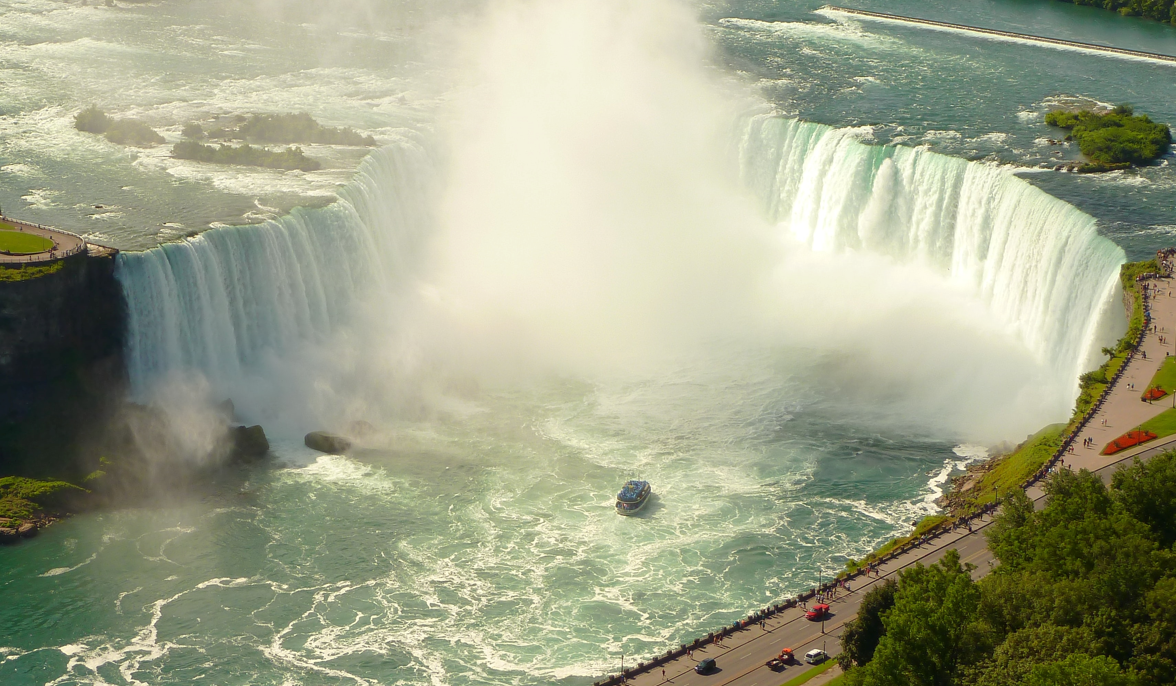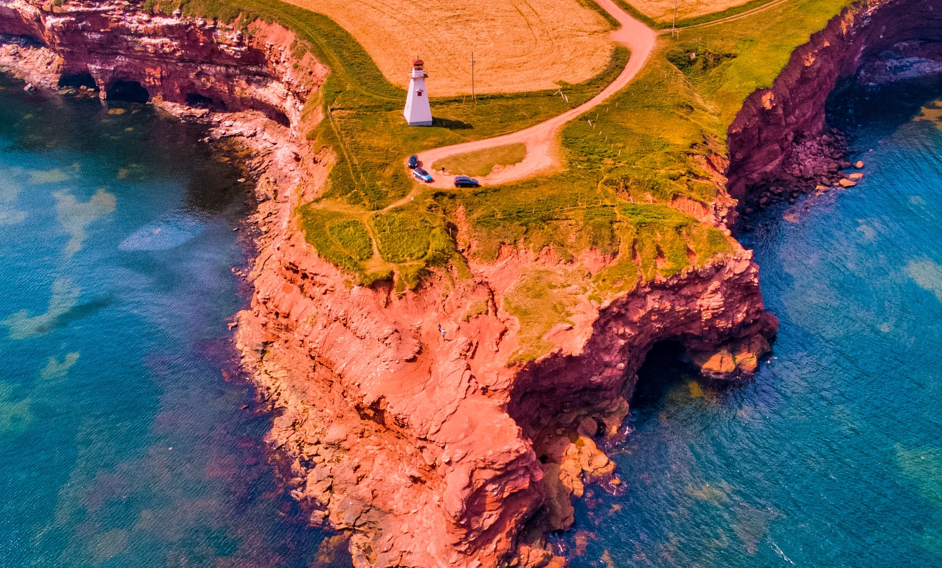The famous waterfalls may be the main draw of this Southern Ontario locale, but the area offers something for everyone
By Rob and Wendy Lindsay
Many of us venture to Niagara Falls— Canada’s largest tourist attraction— only on special occasions, mostly because the crowds can be prohibitive. However, with COVID-19 restrictions having drastically reduced turnout and tourism, a visit to rediscover all the area has to offer might again be in order, especially before the winter weather settles in.
Wet ’n’ wild
On the first leg of our tour, we revisited two of the best ways to experience the mighty power of the falls: the Niagara Parks attraction Journey Behind the Falls, and a boat ride through the mighty mist by Niagara City Cruises (formerly Hornblower cruises).
The year-round Journey Behind the Falls allows for a truly immersive experience and a unique view of the iconic attraction: an elevator takes visitors 125 feet (38 metres) below the brink of the falls to tunnels carved more than 130 years ago into the solid rock. As you proceed through the passageway, you can actually feel the power of the thundering water. This fascinating trek through the bedrock leads to two portals, where you can safely witness the action of the falls from behind the massive sheets of falling water. Your journey then continues to two open-air observation decks beside the roaring water. However, in winter, when conditions are icy, the lower of the two decks is closed to ensure visitors’ safety. Expect to spend a minimum of 30 to 45 minutes on this walking tour.
A Niagara City Cruises boat tour, by contrast, takes you up the river, close to the cascading falls, allowing you to experience the vast power of the water in a very different way. Despite the recyclable ponchos provided by both tour operators, expect to get wet—so dress accordingly for that part of the fun experience.
Bits and bites
Thanks to diminished crowds, we discovered for the first time the second-floor dining terrace at Queen Victoria Place. With its wonderful, unobstructed view of Horseshoe Falls—the Canadian side of Niagara Falls—and of the American falls, it’s become our new favourite spot for lunch. This grand building was constructed in 1904 as a residence for Niagara Parks commissioners. Happily, it’s now a delightful venue for enjoying delicious, locally sourced dinners and Niagara-area wine while taking in the world-famous view. (Wheelchair access is available via the building’s rear entrance, but make sure to ask about any other details you might need when you make your reservation.)
Wonders of light and sound
One of the newest attractions is the Niagara Parks Power Station. When it originally came online in 1905 as the first major power plant on our side of the falls, it was a marvel of engineering and architecture, its generators the largest of their kind in the world at the time. This past summer, the interior of the historic power station was transformed, now offering new exhibits and guest amenities. In September, an immersive sound and light show called “Currents: Niagara’s Power Transformed” began bringing the building to life nightly with state-of-the-art 3-D projection-mapping technology. The show joins the ever popular nightly illumination of the falls, which runs from dusk until early morning yearround, transforming Niagara Parks into a breathtaking multicoloured work of art.
Special lighting is also often projected onto the falls for special occasions, including when registered charities mark significant dates. For example, the waters were bathed in rainbow colours to mark the beginning of Pride month in Ontario, and they were awash in blue and white in honour of the Blue Jays and their return to play in Canada at the end of July. The illuminated Horseshoe Falls were also used as a beautiful backdrop when Canadian singer Alessia Cara filmed the music video for her single “Sweet Dreams” from the deck of a Niagara City Cruises boat.
Thrilling outings
If you have adventurous young people in tow or simply enjoy a thrill yourself, there are plenty of offerings from which to choose. For more than 100 years, the Whirlpool Aero Car, an antique cable car, has been carrying thrill-seekers across the waters, 3,500 feet (1.1 kilometres) above the Niagara Gorge canyon. Or if you dare, try the Zipline to the Falls attraction, a high-wire, high-speed gliding adventure into the mist of Horseshoe Falls—or, in wintertime, over the ice and snow that surround the falls.
Historic Clifton Hill, one block away, is reminiscent of a carnival midway, with its rides, food, interactive games and shows. Marineland, for its part, offers wild rides including several incarnations of roller coaster, twister and Ferris wheel—but check schedules and COVID-19 restrictions before you plan your outing.
Scenic drives and nature tours
More to our liking was a relaxing drive down the Niagara Parkway towards Niagara-on-the-Lake. Turn left from Niagara Falls and follow the well-marked route that Sir Winston Churchill described in 1943 as “the prettiest Sunday-afternoon drive in the world.” We found it every bit as beautiful today.
Parallel to the parkway is the Niagara River Recreation Trail—a 32 mile (53 kilometre) paved walkway that stretches from Fort George in Niagara-on-the-Lake to the town of Fort Erie. On the trail we saw folks happily cycling, hiking, rollerblading and jogging, taking in the fabulous scenery all the while.
Welland Canal
If you have time, take a detour to see the Welland Canal. Set your GPS for the town of Welland, at the centre of Niagara, about a 30-minute drive from Niagara Falls. The canal itself is a 27 mile (43 kilometre) link between Lake Ontario and Lake Erie that allows ships a safe detour around the 164-plus foot (50-plus metre) vertical drop at the falls. You can take in the sights of the canal and its locks from the Welland Canals Parkway—or the paved walking, running and cycling trail that runs alongside it. Driving the parkway can be an impressive sight if a massive ship is in the canal or entering or leaving a lock. The St. Catharines Museum and Welland Canals Centre’s Lock 3 viewing platform—a raised observation deck—provides the very best visual access.
The canal is open from late March to late December.
If photography is a hobby, you can find many stops along the parkway that offer great possibilities. For one, there’s the Niagara Parks Botanical Gardens—with 99 acres of flora, herb and vegetable plantings, and the largest rose garden in Canada. Sharing the grounds is the Niagara Parks School of Horticulture, where students are provided with practical training in perhaps the most beautiful natural classroom setting. We have yet to visit the gardens without encountering a wedding-party photo shoot.
Next door, there’s the Butterfly Conservatory, a massive glass-enclosed structure where your walking tour through a tropical garden oasis puts you up-close-and-personal with more than 2,000 colourful, freely flitting butterflies. Unfortunately, the conservatory was closed due to COVID-19 restrictions (october 2021) the day we attempted a visit—a reminder to call or check the website before you plan your itinerary. Next stop was the nearby Floral Clock, whose 40-foot diameter face includes upwards of 16,000 plants that are refreshed twice a year—as has been the case since the majestic display was first constructed in 1950 by Ontario Hydro. Behind the clock stands a tower, whose Westminster chimes announce every quarter-hour.
Continuing on our drive, we reached Queenston, where we noted Brock’s Monument towering from the top of a hill in Queenston Heights Park. The Classified Federal Heritage Building monument and the park that houses it are part of the larger Queenston Heights National Historic Site of Canada, altogether a beautiful spot with great views. The monument commemorates Sir Isaac Brock, who was killed in the Battle of Queenston Heights while leading his troops to victory over the American forces in the War of 1812.
Our second stop, Laura Secord Homestead, also has ties to the War of 1812: The house is the restored residence of the heroic Canadian civilian whose perilous 20 mile (32 kilometre) trek through bush and swamp to warn the British of a surprise attack contributed to the victory over American soldiers in the Battle of Beaver Dams.
Historic Niagara-on-the-Lake
Carrying onward towards our next destination, we passed at least six wineries and numerous vineyards. The vines were heavily laden with grapes, reminding us that our path was overlaying part of the Niagara Wine Route, which links more than 80 Niagara-on-the-Lake and Niagara Escarpment-area wineries. That insight is certainly an incentive for another trip.
Our idyllic wander past orchards and vineyards continued along the Niagara Parkway. During late summer and early fall, grower-run roadside stands sell their delicious wares, including cherries, peaches, apricots, plums, apples and tomatoes—just-picked freshness at its best. The vendors, often younger people at their first summer jobs, are happy to extol the virtues of their fruits and jams. Trees arch overhead and traffic is usually light on this road less travelled—a marvellous way to spend a fall day.
Finally arriving at Niagara-on-the-Lake—one of the best-preserved historic towns in all of North America— we saw beautiful gardens everywhere, plus many stately neoclassical and Georgian homes that had been converted into fine B & Bs. The town, designated a National Historic District, boasts the famous Queen Street—with its quaint Victorian storefronts housing a myriad of charming specialty shops—and the Memorial Clock Tower/Cenotaph.
Two other architectural attractions on the street are the 19th-century Niagara Apothecary museum and the elegant Prince of Wales Hotel, first built in 1864 and later restored to its original glory. As befits the setting, just outside of the hotel entrance you can arrange a horse-drawn coach tour of the town. Inside, we were happy to learn that the iconic Afternoon Tea at the Prince of Wales—with its touch of Old World charm, delicious sandwich squares, scones and clotted cream—had been reinstated. It seems not even pandemic-related lockdowns can stop tea time, though the hotel added a restrictions-conscious twist by forgoing the usual multitiered-plate presentation, instead packaging our snacks in an elegant takeout box.
This pretty little town usually attracts thousands of theatregoers each year to its world-famous Shaw Festival.
Home to one of the largest repertory companies in North America, the Shaw specializes in the plays of Nobel Prize-winning Dubliner George Bernard Shaw and his contemporaries. To accommodate COVID-19 restrictions, the theatre adapted its usual summer and fall indoor shows to an outdoor setting with the Outdoors @ The Shaw festival—adding concerts and other open-air events to the celebration. So whether or not current indoor health measures will stand next year, it seems you can be sure that at the Shaw Festival, the show must go on.
If you go
➻ Niagaraparks.com: For up-to-date information, reservations and to book adventure packages at Niagara Parks; Journey Behind the Falls, the Butterfly Conservatory, the botanical gardens and many other attractions detailed here are under the umbrella of Niagara Parks Commission
➻ shawfest.com: For information on the Outdoors @ The Shaw festival
➻ stcatharines.ca/museum: For hours and other info on the Welland Canals Centre Lock 3 viewing platform
➻ covid-19.ontario.ca: For current information on COVID-19 restrictions and rules in Ontario






